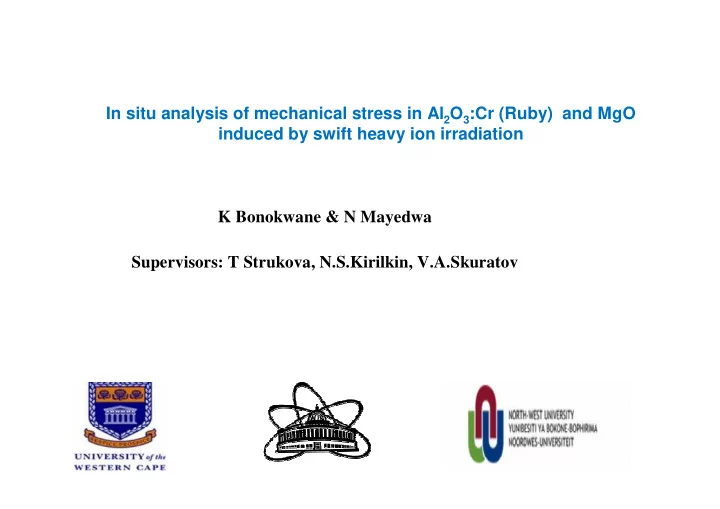

In situ analysis of mechanical stress in Al 2 O 3 :Cr (Ruby) and MgO induced by swift heavy ion irradiation K Bonokwane & N Mayedwa Supervisors: T Strukova, N.S.Kirilkin, V.A.Skuratov
Brief project overview The irradiation testing of nuclear ceramics and oxides with heavy ions of fission fragment energy • The radioactive waste is one problem which the nuclear power stations come up against, so the inert matrices fuels were introduced as one of the concepts in reducing the waste. • The material to be used as inert matrices for transmutation of minor actinides should be resistant to radiation damage caused by fission fragment The aim of this study is to investigate radiation damage induced by swift heavy ions (E= 1-3 MeV/amu) in several ceramics and single crystals (MgO, Al2O3, ZrO) in order to quantify them as candidates for inert matrices fuel • One useful method to study the radiation damage is the optical spectroscopy known as photoluminescence
The experimental work • Ruby is crystalline alumina (Al 2 O 3 ) in which a small fraction of the Al 3+ ions have been replaced by chromium ions, Cr 3+ . • It is the chromium ions that give rise to the characteristic pink or red color of ruby and it is in these ions that a population inversion is set up in a ruby laser .
Basis of the piezospectroscopic effect – the applied stress strains the lattice and alters the energy of transitions between electronic states ∆ν = Π ij × σ ij Π ij – piezospectroscopic coefficients R1-line 2 . 56 0 0 − Π = 1 0 3 . 50 0 / cm GPa ij 0 0 1 . 53 R2-line 2 . 65 0 0 − Π = 1 0 2 . 80 0 cm / GPa ij Typical piezospectroscopic probes: Cr 3+ in Al 2 O 3 0 0 2 . 16 Hydrostatic stress level σ h (GPa) ≈ ∆ν 2 (cm -1 )/7.61 D. Clarke et. al. Non-Contact Methods of Measuring Stresses in High Temperature Materials
Xe(167 MeV), 80K 10 cm -2 10 8000 12 cm -2 9x0 13 cm -2 1.8x0 6000 IL signal, a.u 4000 2000 0 14340 14360 14380 14400 14420 -1 wavenumber, cm
Xe The threshold of damage formation S e =25 keV/nm through dense ionization is about 20 keV/nm. B. Canut et al. PRB 51 (1995) 12194. ! No stress relaxation occurs if S e Ion fluence, cm -2 less than threshold value of damage formation via electronic excitation wavenumber, cm -1
each Cr 3+ ion acts as an The splitting of the R -lines directly indicates on the presence of differently stressed regions in the irradiating ruby independent strain sensor specimen Xe Kr Bi Ion fluence, cm -2 S e =25 keV/nm S e =16 keV/nm S e =41 keV/nm wavenumber, cm -1 The stresses are compressive in basal plane of the sample and tensile in perpendicular direction
Examination of the dense ionization effect in ceramics and oxides with heavy Examination of the dense ionization effect in ceramics and oxides with heavy ions of fission fragments energy ions of fission fragments energy Step heights formed on the surfaces of MgAl 2 O 4 and Al 2 O 3 along a border of masked and 85 MeV I +7 ion irradiated area. Ion fluence 1.2 × 10 19 m- 2 . The swelling due to amorphization is estimated to be around 15–20% T. Aruga et al. / NIM B 197 (2002) 94– 100
Examination of the dense ionization effect in ceramics and oxides with heavy Examination of the dense ionization effect in ceramics and oxides with heavy ions of fission fragments energy ions of fission fragments energy XTEM image of polycrystalline MgAl 2 O 4 sample irradiated with 85 MeV I +7 ions to 0.28 × 10 19 m- 2 (a) and 1.2 × 10 19 m- 2 (b) No amorphization occurs for MgO samples even at the fluence of 1.2 × 10 19 m- 2 T. Aruga et al. / NIM B 197 (2002) 94– 100
Summary Piezospectroscopic method was explored for monitoring of the build up and accumulation of mechanical stresses in alumina irradiated with high energy heavy ions. in situ ionoluminescence reveals high level compressive stresses in Al 2 O 3 :Cr crystals. Stress accumulation proceeds in several stages if the electron stopping power exceeds the threshold of radiation damage formation via electronic excitations. It is suggested that ion track region overlapping may stimulate the stress relaxation processes.
Acknowledgements • National Research Fund (NRF) • Joint Institute for Nuclear Research (JINR) • Prof M L Lekala • Dr N M Jacobs • M r. N. S. Kirilkin • M r Vusi M alaza
Thank You
Recommend
More recommend